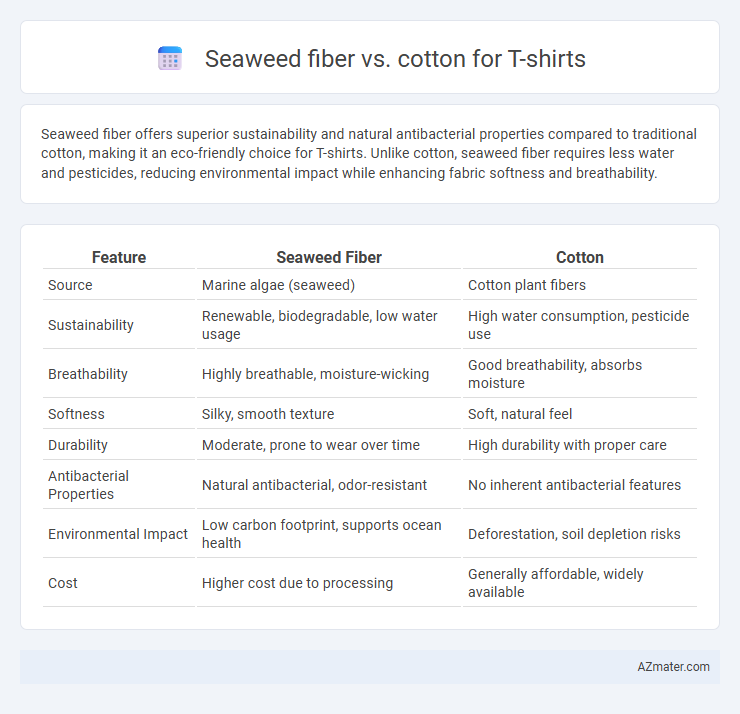Seaweed fiber offers superior sustainability and natural antibacterial properties compared to traditional cotton, making it an eco-friendly choice for T-shirts. Unlike cotton, seaweed fiber requires less water and pesticides, reducing environmental impact while enhancing fabric softness and breathability.
Table of Comparison
| Feature | Seaweed Fiber | Cotton |
|---|---|---|
| Source | Marine algae (seaweed) | Cotton plant fibers |
| Sustainability | Renewable, biodegradable, low water usage | High water consumption, pesticide use |
| Breathability | Highly breathable, moisture-wicking | Good breathability, absorbs moisture |
| Softness | Silky, smooth texture | Soft, natural feel |
| Durability | Moderate, prone to wear over time | High durability with proper care |
| Antibacterial Properties | Natural antibacterial, odor-resistant | No inherent antibacterial features |
| Environmental Impact | Low carbon footprint, supports ocean health | Deforestation, soil depletion risks |
| Cost | Higher cost due to processing | Generally affordable, widely available |
Introduction: The Rise of Sustainable Fibers
Seaweed fiber offers eco-friendly advantages over traditional cotton, using less water and reducing chemical inputs throughout cultivation and processing. Seaweed-derived fabric boasts renewable, biodegradable qualities that align with sustainable fashion trends, while cotton's environmental impact remains significant due to high water usage and pesticide reliance. The increasing consumer demand for greener alternatives is driving innovation and adoption of seaweed fiber in T-shirt production.
What Is Seaweed Fiber?
Seaweed fiber is an innovative, sustainable material derived from seaweed extracts combined with natural fibers like cotton or bamboo to create eco-friendly textiles. This fiber offers benefits such as natural antibacterial properties, moisture-wicking capabilities, and enhanced softness, making it ideal for T-shirt production. Compared to traditional cotton, seaweed fiber significantly reduces water usage and environmental impact, promoting a greener alternative in fashion.
Cotton: A Traditional Textile Staple
Cotton remains the dominant textile staple for T-shirts due to its natural breathability, softness, and durability, making it ideal for everyday wear. As a biodegradable, renewable resource, cotton fibers provide superior moisture absorption compared to synthetic alternatives, ensuring comfort in warm climates. Its widespread availability and established manufacturing processes make cotton a cost-effective choice for mass production in the apparel industry.
Environmental Impact: Seaweed Fiber vs Cotton
Seaweed fiber production generates significantly lower greenhouse gas emissions and requires less water compared to conventional cotton farming, reducing environmental strain. Seaweed cultivation also aids in marine ecosystem health by absorbing CO2 and filtering pollutants, whereas cotton agriculture often involves heavy pesticide use and soil degradation. Choosing seaweed fiber over cotton for T-shirts supports sustainable textile practices with a smaller ecological footprint.
Production Process Comparison
Seaweed fiber production involves extracting cellulose from seaweed using eco-friendly, low-energy processes that minimize chemical use and water consumption, making it a sustainable alternative to conventional fibers. Cotton cultivation requires extensive water, pesticides, and land, impacting the environment significantly through resource-intensive irrigation and chemical inputs. Seaweed fiber's closed-loop production system contrasts sharply with cotton's heavy reliance on agricultural resources, positioning it as a lower-impact option for T-shirt manufacturing.
Comfort and Wearability
Seaweed fiber offers superior moisture-wicking properties and natural antibacterial benefits, enhancing comfort and freshness in T-shirts compared to cotton. Its smooth texture reduces skin irritation, making it ideal for sensitive skin and active wear. While cotton is breathable and soft, seaweed fiber provides a more eco-friendly option with improved durability and stretch for better wearability.
Durability and Longevity
Seaweed fiber offers superior durability compared to cotton due to its natural strength and resistance to wear, making it ideal for long-lasting T-shirts. Cotton fibers tend to weaken and pill over time, especially with frequent washing, whereas seaweed fiber maintains its structural integrity and resists fading. This enhanced longevity of seaweed fiber garments ensures sustained comfort and eco-friendly benefits without compromising durability.
Cost and Market Availability
Seaweed fiber T-shirts generally have higher production costs due to limited processing technology and smaller-scale availability, making them less affordable than traditional cotton. Cotton remains the dominant fiber in the T-shirt market because of its widespread cultivation, established supply chains, and relatively low price. Market availability for seaweed fiber is currently niche and region-specific, while cotton benefits from global mass production and extensive retail presence.
Health and Skin Benefits
Seaweed fiber for T-shirts offers anti-bacterial and anti-inflammatory properties, promoting healthier skin by reducing irritation and redness compared to conventional cotton. Rich in vitamins and natural minerals, seaweed fabric enhances moisture retention and supports skin hydration, making it ideal for sensitive or allergy-prone skin. Cotton, while breathable and soft, lacks the bioactive compounds found in seaweed fiber that actively benefit skin health during wear.
Future Trends in T-shirt Fabrics
Seaweed fiber offers a sustainable alternative to traditional cotton with its biodegradable properties and lower water consumption during cultivation, aligning with rising eco-conscious consumer demand. Innovations in seaweed fiber processing enhance fabric softness and durability, making it competitive with cotton for comfortable, long-lasting T-shirts. Future trends indicate a growing adoption of seaweed-based textiles driven by environmental benefits, regulatory pressures on water usage, and the fashion industry's shift toward circular economy practices.

Infographic: Seaweed fiber vs Cotton for T-shirt
 azmater.com
azmater.com